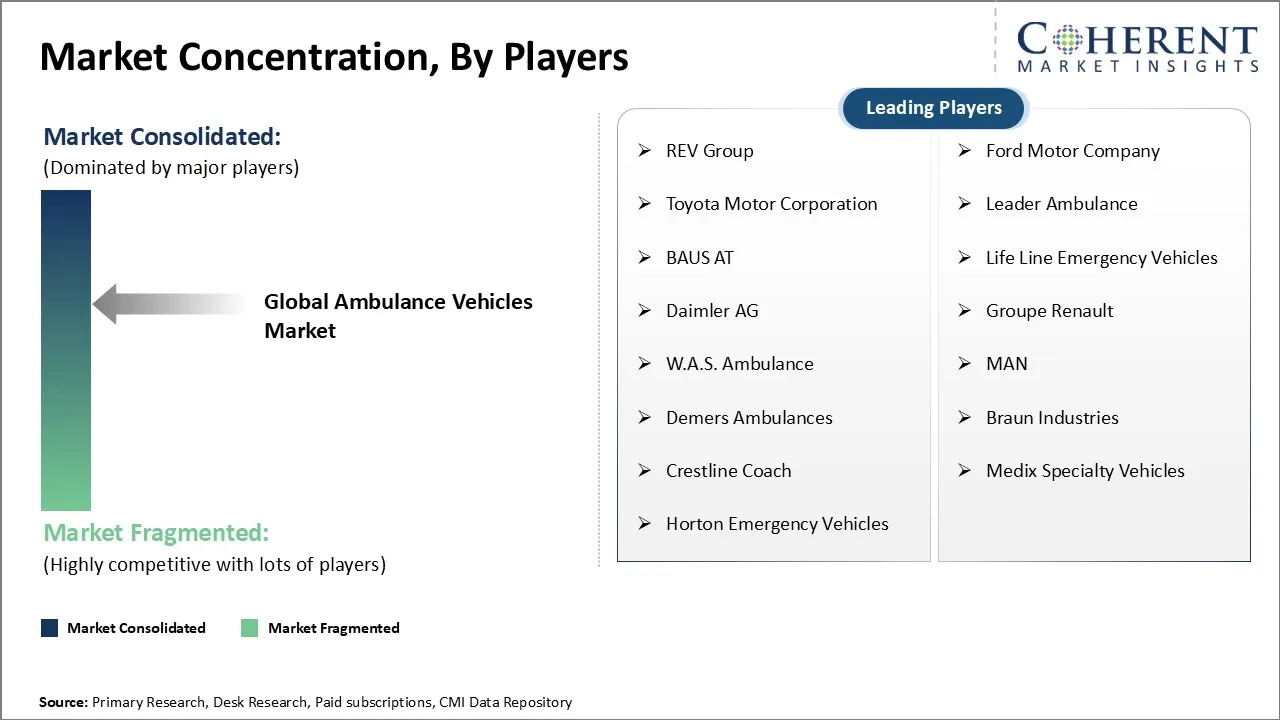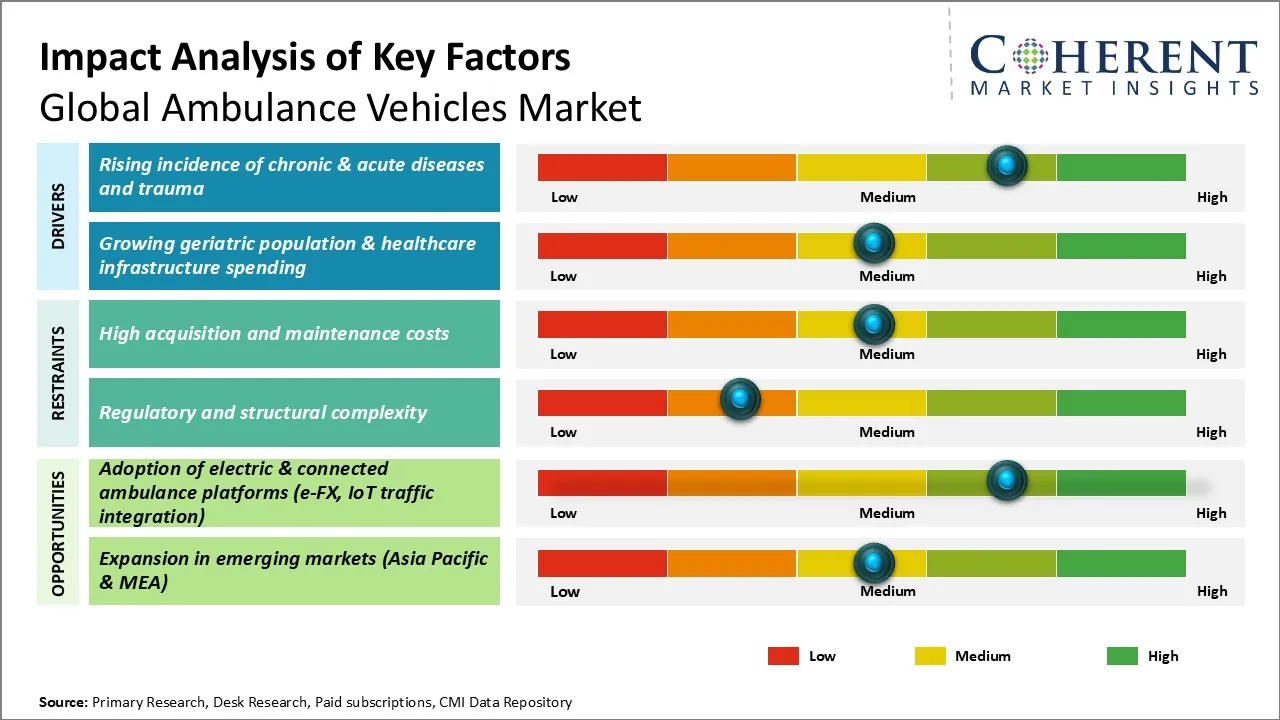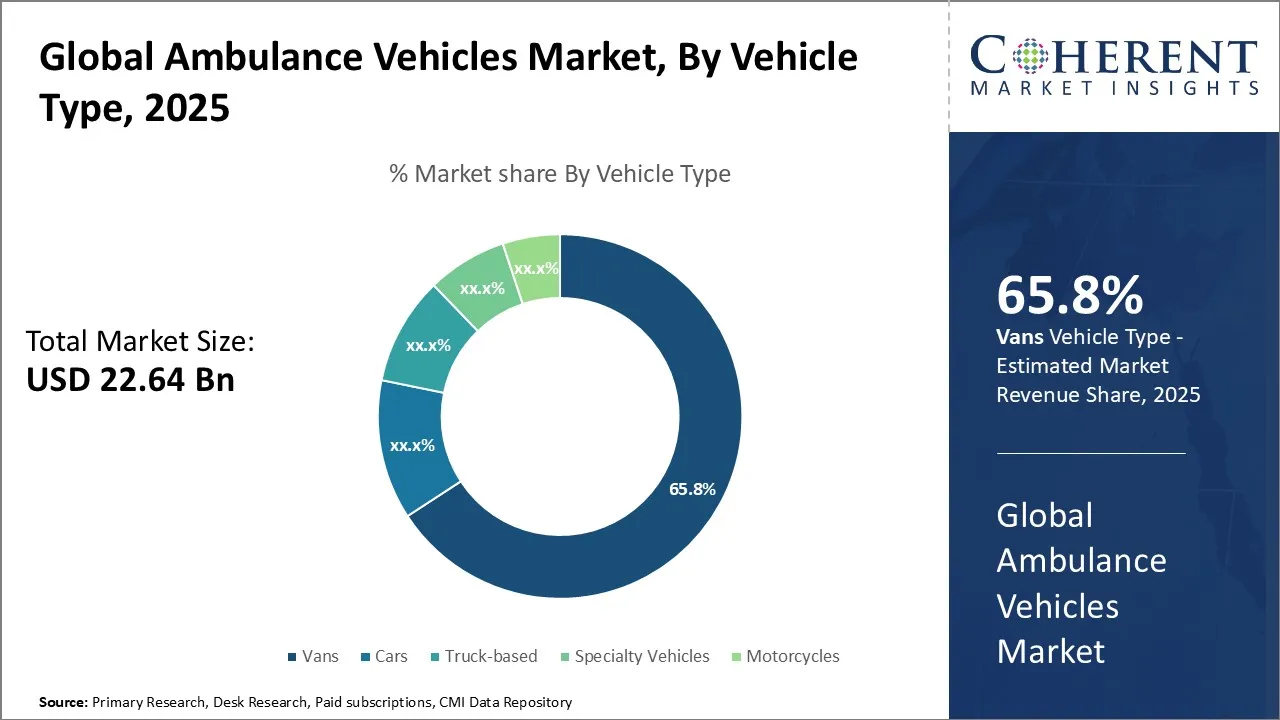Global Ambulance Vehicles Market Size and Forecast – 2025-2032
The Global Ambulance Vehicles Market is estimated to be valued at USD 22.64 Bn in 2025 and is expected to reach USD 31.43 Bn by 2032, growing at a compound annual growth rate (CAGR) of 4.8% from 2025 to 2032.
Key Takeaways of the Ambulance Vehicles Market
- The vans segment leads the market, holding an estimated share of 65. 8% in 2025.
- The Advance Life Support (ALS) segment is projected to dominate with a share of 64. 1% in 2025.
- North America is estimated to lead the market with a share of 37. 6% in 2025.
- Asia Pacific, holding a share of 21. 4% in 2025, is projected to be the fastest growing region.
Market Overview
The ambulance vehicles market is witnessing a significant growth trend due to the increasing demand for emergency medical services, coupled with the rising prevalence of chronic diseases and accidents. Also, technological advancements in ambulance vehicles, such as the integration of advanced life support systems and telemedicine capabilities, will add to market growth. Additionally, government initiatives to improve healthcare infrastructure and increase funding for emergency medical services are anticipated to further fuel the growth of the ambulance vehicles market during the forecast period.
Current Events and Its Impact
|
Current Events |
Description and its impact |
|
Global Healthcare Infrastructure Investment Initiatives |
|
|
Technological Innovations and Adoption in Emergency Medical Services (EMS) |
|
Uncover macros and micros vetted on 75+ parameters: Get instant access to report
Global Ambulance Vehicles Market Insights, by Vehicle Type – Vans Dominate due to their Spaciousness
The vans segment is expected to contribute the highest share of 65.8% in the market in 2025. Vans offer a perfect balance between maneuverability and patient care, making them the go-to choice for emergency medical services (EMS) providers worldwide. They can accommodate many different medical equipment and personnel. The spacious interior of vans allows for the installation of advanced life support systems, such as ventilators, defibrillators, and monitoring devices, while still providing ample room for paramedics to work efficiently.
Moreover, vans offer excellent versatility in terms of customization options. EMS providers can easily modify the interior layout of vans to suit their specific needs, such as adding specialized storage compartments, adjustable stretchers, and ergonomic seating for the medical crew. This flexibility enables ambulance services to optimize their vehicles for maximum efficiency and patient comfort.
Global Ambulance Vehicles Market Insights, by Equipment Level - Vehicle Advanced Life Support (ALS) is Driving the Future of Emergency Medical Care
The Advanced Life Support (ALS) segment is expected to contribute the highest share of 64.1% in the global ambulance vehicles market in 2025. The growing demand for ALS ambulances is driven by the increasing prevalence of critical illnesses, technological advancements in medical equipment, and the rising awareness of the importance of prompt and effective emergency care.
ALS ambulances are equipped with state-of-the-art medical devices and staffed by highly trained paramedics and emergency medical technicians (EMTs). These vehicles are designed to provide comprehensive medical care to patients with life-threatening conditions, such as cardiac arrests, severe trauma, and respiratory failures. The ability to perform advanced procedures, such as intubation, defibrillation, and medication administration, on-site and during transportation, is a key factor driving the growth of the ALS segment.
Technological advancements in medical equipment have significantly enhanced the capabilities of ALS ambulances. Portable ventilators, multi-parameter monitors, and point-of-care testing devices enable paramedics to diagnose and treat patients more effectively in the pre-hospital setting. These innovations have improved patient outcomes and reduced the time taken to deliver critical care, further fueling the demand for ALS ambulances.
Impact of AI on the Ambulance Vehicles Market
Artificial Intelligence (AI) is significantly transforming the ambulance vehicles market by enhancing response efficiency, optimizing route navigation, and enabling predictive maintenance. AI-powered dispatch systems integrate real-time traffic data, weather conditions, and patient vitals to select the fastest and safest routes for ambulances, thereby reducing critical response times. Advanced ambulance models are now being equipped with AI-integrated telemedicine systems, enabling paramedics to transmit real-time patient data to hospital emergency departments, ensuring doctors are better prepared upon arrival. These systems also support clinical decision-making in transit, improving treatment outcomes in life-threatening situations.
A notable example of AI implementation in ambulance systems is the partnership between Apollo Hospitals and HealthNet Global (India), which launched AI-enabled ambulances capable of transmitting real-time ECGs and patient vitals directly to specialists. These ambulances are also connected to central command centers that use AI algorithms to assess triage severity and advise on hospital destination, bypassing less-equipped facilities.
Regional Insights

To learn more about this report, Download Free Sample
North America Ambulance Vehicles Market Analysis and Trends
North America, holding a share of 37.6% in 2025, is expected to dominate the global ambulance vehicles market. The region boasts a well-established healthcare infrastructure, stringent regulations governing emergency medical services, and a high demand for advanced ambulance vehicles. The presence of major ambulance manufacturers, such as Ford, General Motors, and REV Group, further strengthens North America's position in the market. REV Group, a major U.S.-based manufacturer, introduced the Zero-Emissions Ambulance (ZEV) through its subsidiary, Leader Emergency Vehicles, in partnership with Lightning eMotors.
Asia Pacific Ambulance Vehicles Market Analysis and Trends
Asia Pacific, holding a market share of 21.4% in 2025, is estimated to exhibit the fastest growth in the global ambulance vehicles market. The region's rapid economic development, increasing healthcare expenditure, and improving healthcare infrastructure are key drivers of market growth. Additionally, the presence of local manufacturers and the increasing number of startups are contributing to the market's growth in the Asia Pacific region. StanPlus, a leading emergency response startup based in India, has launched “Red Ambulances”, a fleet of AI-enabled vehicles equipped with real-time GPS, predictive dispatch algorithms, and live health data monitoring systems.
Global Ambulance Vehicles Market Outlook for Key Countries:
U.S. Ambulance Vehicles Market Analysis and Trends
The U.S. ambulance vehicles market is characterized by a strong emphasis on innovation and technological advancements. Major players like Ford, General Motors, and REV Group are at the forefront of developing state-of-the-art ambulance vehicles equipped with advanced life support systems, telemedicine capabilities, and improved safety features. The country's well-established healthcare system, coupled with stringent regulations and standards for ambulance vehicles, ensures a consistent demand for high-quality vehicles. Furthermore, the increasing focus on patient comfort and the need for specialized ambulances for specific medical conditions contribute to the market's growth in the United States.
China Ambulance Vehicles Market Analysis and Trends
China ambulance vehicles market is experiencing significant growth due to the country's expanding healthcare sector and increasing government investments in emergency medical services. The rising prevalence of chronic diseases, coupled with a large and aging population, is driving the demand for ambulance vehicles in China. Local manufacturers, such as Brilliance Auto and Jiangling Motors Corporation, are actively involved in the production of ambulance vehicles, while international players are also establishing their presence in the market through partnerships and collaborations.
Germany Ambulance Vehicles Market Analysis and Trends
Germany continues to lead the European market for ambulance vehicles, owing to its advanced healthcare system, strong focus on research and development, and stringent quality standards. German manufacturers, such as Mercedes-Benz and BMW, are renowned for their high-end ambulance vehicles that incorporate cutting-edge technology and premium features. Additionally, Germany's well-established automotive industry and expertise in engineering contribute to the production of reliable and efficient ambulance vehicles.
India Ambulance Vehicles Market Analysis and Trends
India ambulance vehicles market is witnessing significant growth due to the increasing demand for emergency medical services, rising healthcare expenditure, and government initiatives to improve healthcare infrastructure. Local manufacturers, such as Force Motors and Tata Motors, are actively involved in the production of ambulance vehicles, while international players are also eyeing the Indian market for growth opportunities. The Indian government's schemes, such as the National Ambulance Service (NAS) and the Emergency Medical Service (EMS) projects, are further boosting the demand for ambulance vehicles in the country.
Market Players, Key Development, and Competitive Intelligence

To learn more about this report, Download Free Sample
Key Developments
- In May 2025, MAN presented its innovative fire and rescue service vehicles and ambulances to international trade visitors at the RETTmobil in Fulda, Germany. MAN presented two ambulances: a MAN TGE 3.160 4x4 panel van with 163 hp (120 kW) with the VALERIS V21 equipment from Ambulanz Mobile; and the MAN TGE 3.140 4x2 panel van with 140 hp (103 kW) has a BINZ body.
- In August 2024, Road Rescue, a brand of REV Ambulance Group Orlando, Inc., a subsidiary of REV Group, Inc., and a premier manufacturer of ambulances popular with hospitals and fire departments, announced that its easy-to-spec, preconfigured RediMedic ambulance is available to order.
- In April 2024, Medix Specialty Vehicles, a leader in ambulance manufacturing, displayed three uniquely built ambulances at FDIC 2024: the MSV-II 170 and 157 Type I’s, and the Metro Express 166 Type III.
- In July 2022, Demers Ambulances demonstrated its new all-electric Type 3 eFX ambulance prototype during a private fleet electrification event hosted by First Priority Group in New Jersey, U.S.
Top Strategies Followed by Global Ambulance Vehicles Market Players
- Established Players: Leading companies in the global ambulance vehicles market prioritize extensive research and development (R&D) investments to innovate high-performance products.
- REV Group (USA), a dominant player in the North American market, invested in the development of the Zero-Emissions Electric Ambulance (ZEV) through a collaboration between its subsidiary Leader Emergency Vehicles and Lightning eMotors.
- Mid-Level Players: Mid-level players in the ambulance vehicles market concentrate on delivering cost-effective solutions to cater to price-sensitive consumers.
- Force Motors (India) offers cost-effective ambulance variants like the Traveller Ambulance, which are widely used by government healthcare services and NGOs across Asia and Africa. These vehicles are built for rugged use and basic life support needs while maintaining affordability.
- Small-Scale Players: Small-scale players in the ambulance vehicles market often focus on niche specialization to differentiate themselves from larger competitors.
- Life Line Emergency Vehicles (USA) specializes in custom-built ambulances tailored to specific paramedic and regional needs. Their focus on bespoke Type I and III ambulances for rural EMS units allows them to serve specialized market segments where large OEMs have limited reach or customization capability.
Market Report Scope
Ambulance Vehicles Market Report Coverage
| Report Coverage | Details | ||
|---|---|---|---|
| Base Year: | 2024 | Market Size in 2025: | USD 22.64 Bn |
| Historical Data for: | 2020 To 2024 | Forecast Period: | 2025 To 2032 |
| Forecast Period 2025 to 2032 CAGR: | 4.8% | 2032 Value Projection: | USD 31.43 Bn |
| Geographies covered: |
|
||
| Segments covered: |
|
||
| Companies covered: |
REV Group, Ford Motor Company, Toyota Motor Corporation, Leader Ambulance, BAUS AT, Life Line Emergency Vehicles, Daimler AG, Groupe Renault, W.A.S. Ambulance, MAN, Demers Ambulances, Braun Industries, Crestline Coach, Medix Specialty Vehicles, and Horton Emergency Vehicles |
||
| Growth Drivers: |
|
||
| Restraints & Challenges: |
|
||
Uncover macros and micros vetted on 75+ parameters: Get instant access to report
Market Dynamics

To learn more about this report, Download Free Sample
Global Ambulance Vehicles Market Driver - Rising Incidence of Chronic & Acute Diseases and Trauma
As the global population continues to age and adopt unhealthy lifestyles, the incidence of chronic diseases such as cardiovascular disorders, respiratory issues, and diabetes is on the rise. According to Japan’s Fire and Disaster Management Agency, emergency transport cases exceeded 6.3 million in 2023, marking a record high. Additionally, the growing number of road accidents, falls, and other traumatic events is leading to a higher demand for emergency medical services and ambulance transportation.
Consequently, the rising incidence of chronic and acute diseases, as well as trauma cases, is expected to fuel the growth of the ambulance vehicles market, as healthcare providers and governments invest in expanding and upgrading their emergency medical services infrastructure to meet the growing demand for prompt and effective medical care.
Global Ambulance Vehicles Market Opportunity - Adoption of Electric & Connected Ambulance Platforms (e-FX, IoT Traffic Integration)
As the world shifts towards sustainable and eco-friendly transportation solutions, the integration of electric powertrains in ambulances offers numerous benefits. Electric ambulances, such as e-FX models, reduce fuel consumption and lower emissions. Additionally, the incorporation of Internet of Things (IoT) technology and traffic integration systems in connected ambulance platforms enhances operational efficiency and emergency response times. Real-time traffic data, route optimization, and intelligent dispatch systems enable ambulances to navigate congested urban areas more effectively, ensuring faster access to patients in critical situations. Demers Ambulances (Canada), in collaboration with Lion Electric, launched the eFX Ambulance, one of the first all-electric, connected ambulances in North America.
Analyst Opinion (Expert Opinion)
- The integration of AI-driven diagnostics and telemedicine within ambulances is transforming emergency response into a mobile extension of the hospital. Real-time transmission of patient vitals, AI-supported triage, and remote consultations are improving survival outcomes.
- Electric ambulances are gaining traction, particularly in North America and Europe, driven by stringent emission regulations and government sustainability mandates. As battery technology matures, EV platforms are becoming viable for urban emergency fleets, with zero-emission designs offering both environmental and operational cost benefits.
- IoT-enabled ambulances, connected to traffic control systems and hospital ERs, are enabling dynamic routing and capacity-aware hospital selection. This “smart ambulance ecosystem” reduces response and transfer times and enhances coordination between dispatch, paramedics, and care providers.
Market Segmentation
- Vehicle Type Insights (Revenue, USD Bn, 2020 - 2032)
- Vans
- Cars
- Truck-based
- Specialty Vehicles
- Motorcycles
- Equipment Level Insights (Revenue, USD Bn, 2020 - 2032)
- Advance Life Support (ALS)
- Basic Life Support (BLS)
- Regional Insights (Revenue, USD Bn, 2020 - 2032)
- North America
- U.S.
- Canada
- Latin America
- Brazil
- Argentina
- Mexico
- Rest of Latin America
- Europe
- Germany
- U.K.
- Spain
- France
- Italy
- Russia
- Rest of Europe
- Asia Pacific
- China
- India
- Japan
- Australia
- South Korea
- ASEAN
- Rest of Asia Pacific
- Middle East
- GCC Countries
- Israel
- Rest of Middle East
- Africa
- South Africa
- North Africa
- Central Africa
- North America
- Key Players Insights
- REV Group
- Ford Motor Company
- Toyota Motor Corporation
- Leader Ambulance
- BAUS AT
- Life Line Emergency Vehicles
- Daimler AG
- Groupe Renault
- A.S. Ambulance
- MAN
- Demers Ambulances
- Braun Industries
- Crestline Coach
- Medix Specialty Vehicles
- Horton Emergency Vehicles
Sources
Primary Research Interviews
Stakeholders
- Emergency Medical Service (EMS) Providers (e.g., Dispatch Managers, Paramedic Coordinators)
- Ambulance Vehicle Manufacturers (e.g., REV Group, Demers, Force Motors)
- Fleet Management Companies for Emergency Vehicles
- Public Health Departments and Government Emergency Response Agencies
- Medical Equipment Integrators (e.g., companies installing ALS/BLS systems)
- Electric Vehicle (EV) Technology Providers for emergency mobility
Databases
- National Highway Traffic Safety Administration (NHTSA)
- Ministry of Health and Family Welfare – India
- Asia-Pacific Mobility Data Exchange (APMDX)
- North American Emergency Response Database (NAERD)
- Global Urban Mobility Indicators (GUMI)
Magazines
- EMS World Magazine
- Ambulance Fleet & Technology Review
- Global Emergency Mobility Digest
- Smart Healthcare Vehicles Quarterly
Journals
- Journal of Emergency Medical Services (JEMS)
- International Journal of Mobile Healthcare Systems
- Journal of Prehospital Emergency Care
- Telematics and Emergency Transport Journal
Newspapers
- HealthTech News Daily
- Urban Mobility Times
- The Health Dispatch (USA)
- Asian Emergency Transport Chronicle
Associations
- International Association of Emergency Vehicle Manufacturers (IAEVM)
- American Ambulance Association (AAA)
- Asia-Pacific EMS Federation (APEMSF)
- Canadian Paramedic Manufacturers Alliance (CPMA)
- Global Alliance for Smart Emergency Mobility (GASEM)
Public Domain Sources
- U.S. Census Bureau
- EUROSTAT
- World Bank
- United Nations Economic and Social Council (UNESC)
- ResearchGate
Proprietary Elements
- CMI Data Analytics Tool, Proprietary CMI Existing Repository of Information for the Last 8 Years.
Share
Share
About Author
Manisha Vibhute is a consultant with over 5 years of experience in market research and consulting. With a strong understanding of market dynamics, Manisha assists clients in developing effective market access strategies. She helps medical device companies navigate pricing, reimbursement, and regulatory pathways to ensure successful product launches.
Missing comfort of reading report in your local language? Find your preferred language :
Transform your Strategy with Exclusive Trending Reports :
Frequently Asked Questions
EXISTING CLIENTELE
Joining thousands of companies around the world committed to making the Excellent Business Solutions.
View All Our Clients


